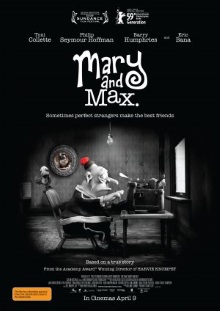
As a claymation movie, and especially one that is about a girl in Australia who has a pet chicken being pen pals with a man in America, you wouldn’t expect it to be very dark. Mary and Max however is one of the most depressing films I’ve watched this year and is most certainly not suitable for children no matter how cute its animation is.
Mary is a lonely girl who is teased at school for a birthmark on her forehead and is neglected by her emotionally distant parents. One day she decides on a whim to write a letter to someone in America by randomly picking a name from a telephone directory. The letter is received by Max, an equally lonely middle-aged man who has difficulty socially interacting with people due to a condition that is later diagnosed to be Asperger’s. Thus begins their unlikely friendship which would continue in fits and starts even as Mary grows into an adult and decides to become a psychologist who specializes in the syndrome.
Most of the film is in goth blacks, white and grays so that the odd spot of color, such as Max’s yarmulke, stands out. The animation quality is excellent and the scenes show plenty of creativity. The camera is so lively that sometimes it’s hard to believe that no CGI was used, though I understand that the images are edited to remove the visible rigging that support the puppets. The voicework is notable in that Max is voiced by Phillip Seymour Hoffman though one thing that annoys me is that the storytelling relies so heavily on narration. It makes me feel as if the film hasn’t really started until the narration ends and the characters get to speak for themselves. Still, pretty impressive work as the debut feature by director Adam Elliot.
Elliot also wrote the story himself and claims that it has some basis in reality from his own correspondence with a pen-pal. Whatever the source, Max is undeniably a sophisticated character who doesn’t fall neatly into the usual pigeonholes. He’s a Jew who slowly became an atheist after reading enough books about religion. Despite his tendency to be paralyzed due to anxiety attacks and difficulty with people which forces him to take menial jobs, he is clearly an intelligent person as is obvious from the letters he writes to Mary. One of the most powerful moments in the film for me was when Mary wrote a book about her correspondence with Max and suggested that she would work on curing his condition. Max reacts angrily, perceiving this as a form of betrayal that she would publicize their private letters without his permission and astutely noting that though he would like to be better able to understand other people, curing his condition would mean that he would no longer be himself.
The upshot that this is surprisingly honest and effective portrayal of mental illness. Contrary to the usual tropes, the psychiatrist in the film offers solid, useful advice and managing Max’s condition requires time, medication and active medical treatment. I was upset at first that the film has a scene showing Max undergoing electroconvulsive therapy thinking that it is now outmoded but a quick search indicates that it is still in use and is actually considered effective in the most severe cases of depression. The only real complaint I have left is that just about every character in the film is depicted as having some mental ailment or other.
Despite the seriousness of its subject matter, the film’s brand of dark humor makes it very funny, though at no point do you feel like you’re making fun of these unfortunate people. Most of all however, Mary and Max achieves the amazing feat of making you feel sorry about characters that you would most likely detest if you met them in real-life. It convinces you that the mentally ill often having excellent reasons for behaving in the way that they do even if those reasons are inscrutable to you and that they can live worthy and even satisfying lives in spite of their illness.